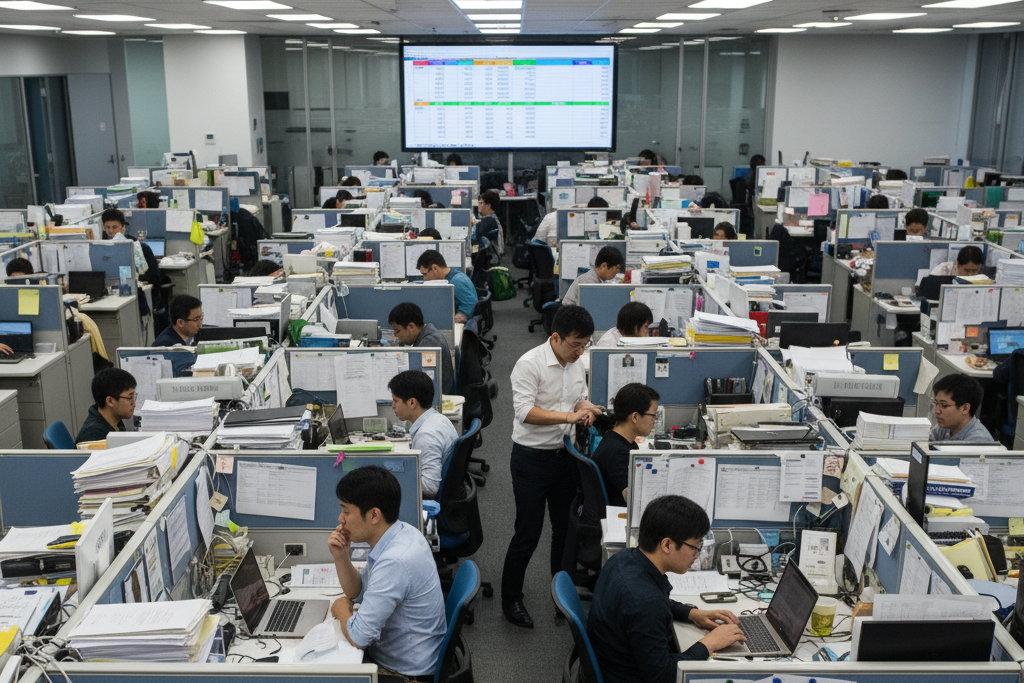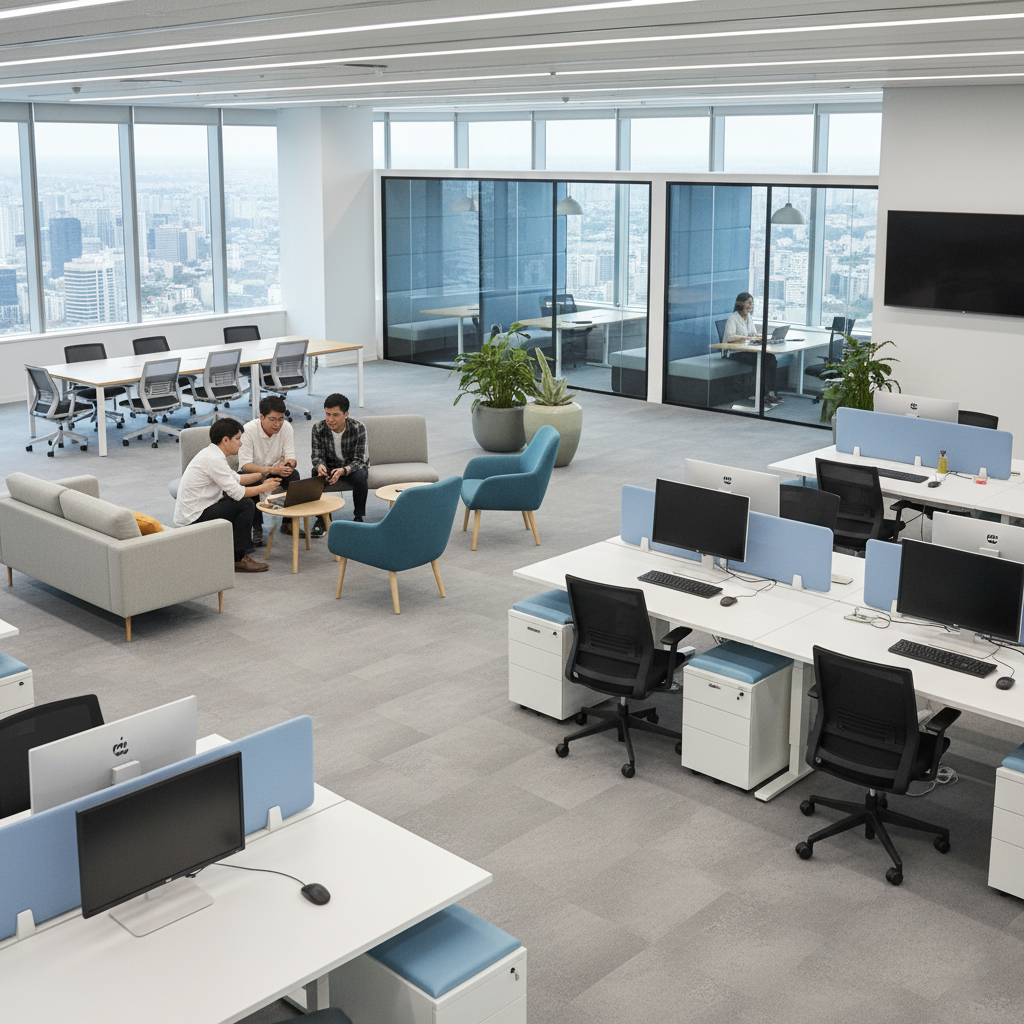7 Costly Hybrid Office Design Mistakes That Waste Money
Introduction: Expensive Lessons We've Learned
After designing dozens of hybrid offices across Singapore, we've seen the same expensive mistakes repeated over and over. The good news? They are all preventable if you know what to watch for. This guide shares the seven most costly mistakes we have seen companies make, and more importantly, how to avoid them. Each mistake costs thousands of dollars and months of frustration.
Mistake #1: Not Enough Small Meeting Rooms
The Problem
Companies design hybrid offices based on their old space ratios: maybe 1 meeting room per 20 employees. But in hybrid offices, meetings become the primary reason people come to the office. The result? A booking war. Meeting rooms are 100% booked. People take video calls at their desks (defeating the purpose of coming in). Teams can't find space to collaborate. Frustration spreads.
Why This Happens
Traditional space planning focuses on desks. The formula was simple: count employees, allocate desks, add some meeting rooms. Hybrid planning flips this. When people can do focused work from anywhere, they come to the office specifically for collaboration, which requires meeting spaces.
The Real Numbers
Traditional Office: 1 meeting room per 15-20 people
Hybrid Office: 1 small meeting room per 8-10 people
For a 100-person hybrid office, you need:
10-12 small meeting rooms (4-6 people)
3-4 medium meeting rooms (8-10 people)
1-2 large meeting rooms (12+ people)
8-10 phone booths (1-2 people)
That's approximately 25 bookable spaces for 100 people—far more than traditional offices.
The Cost of Getting It Wrong
Retrofit meeting rooms after move-in: S$80,000-$120,000 per room (construction, acoustic treatment, AV equipment, furniture, disruption costs)
How to Avoid It
Before planning any desks, calculate meeting room requirements based on actual collaboration patterns. Survey employees: "How many hours per week do you need meeting space?" Multiply by expected attendance. That's your meeting room capacity requirement.
Build phone booths cheaply (modular pods are S$8,000-$15,000) but build enough of them. It's better to have 10 phone booths and 5 meeting rooms than 8 meeting rooms and 2 phone booths.
Mistake #2: Terrible Acoustics
The Problem
Open plan offices with hard surfaces everywhere. Sound bounces off glass, concrete, and hard ceilings. Conversations from 10 meters away sound like they're next to you. Phone calls are impossible. Focus work is a fantasy. People start working from home specifically to escape the noise—defeating the purpose of having an office.
Why This Happens
Acoustic design is invisible when done well. It's easy to cut from budgets. Many designers focus on visual aesthetics and forget that offices are fundamentally audio environments. Glass walls look modern in renderings but create acoustic nightmares in reality.
The Real Impact
Poor acoustics = Lower attendance + Lower productivity + Higher complaints
In one project we audited, noise was the #1 complaint (mentioned by 73% of employees). After acoustic improvements, office attendance increased 25% and satisfaction scores doubled.
What Good Acoustics Costs
Basic Level (Functional):
Acoustic ceiling tiles: S$35-$50 PSM
Acoustic panels: S$150-$300 each
Sound-absorbing furniture: S$2,000-$5,000 per space
Total for 1,000 sqm office: S$50,000-$80,000
Premium Level (Excellent):
High-NRC ceiling system: S$50-$75 PSM
Custom acoustic treatments: S$300-$600 each
Sound masking system: S$25-$35 PSM
Acoustic glass: S$400-$600 PSM
Total for 1,000 sqm office: S$120,000-$180,000
Cost of Retrofitting Poor Acoustics
S$150,000-$250,000 (everything costs more when you're working around occupied space, plus business disruption)
How to Avoid It
Budget for acoustics from day one. Make it non-negotiable like HVAC or electrical. Hire an acoustic consultant (S$8,000-$15,000 for a mid-sized office)—they'll save you far more than they cost.
Prioritize acoustic ceiling everywhere. It's the highest-impact, lowest-cost intervention.
Use acoustic panels strategically in open areas, meeting rooms, and circulation paths.
Test materials before installation. Not all "acoustic" products perform equally.
Mistake #3: Over-Optimizing Space - The "Spreadsheet Trap"
The Problem
Excel says 60% attendance means you need 60 desks for 100 people. So that's what you build. Then 75 people show up on Monday and chaos ensues. People sit in unsuitable spaces. Meeting rooms become desks. Frustration builds. Leaders mandate fewer office days because "there isn't enough space."
Why This Happens
Financial pressure drives over-optimization. Real estate is expensive. Spreadsheets show average attendance is 60%. CFO approves 0.6 ratio. Disaster follows. The problem: averages hide peaks. 60% average might mean 75-80% on Mondays and Thursdays.
The Real Numbers
If your average attendance is 60%, plan capacity for 70-75%. This 10-15% buffer handles:
Peak days (Mondays, Thursdays)
Seasonal variations (higher attendance in busy quarters)
Growth (new hires before you expand space)
Preference clustering (popular teams/neighborhoods fill up)
For 100 employees with 60% average attendance:
Spreadsheet math: 60 desks
Reality-based math: 70-75 desks + flex spaces
The Cost of Over-Optimization
Lost productivity: People waste 30+ minutes finding space
Higher attrition: "The office doesn't work" becomes reason for leaving
Wasted real estate: Space that's too small is as wasteful as space that's too large
Emergency retrofit: Adding capacity later costs 2-3x more than building it right initially
How to Avoid It
Always plan for peaks, not averages. Track actual daily occupancy for 2-4 weeks (desk sensors, badge swipes, or manual counts). Look at the 80th percentile, not the average.
Build in flex capacity. Some desks can be in "floating" areas that handle overflow. Not every workstation needs to be a perfect permanent desk.
Accept that some spaces will be underutilized on Fridays. That's okay—it's insurance for peak days.
Mistake #4: Forgetting About Storage
The Problem
You've designed beautiful hot desking neighborhoods. Open, clean, minimal. Then reality hits: backpacks under desks, coats on chairs, personal items scattered everywhere. The clean aesthetic becomes cluttered chaos in two weeks. Employees hate hot desking because they have nowhere to put their belongings. Your beautiful design becomes a locker-room mess.
Why This Happens
Designers focus on primary spaces (desks, meeting rooms) and forget about support functions. Storage isn't exciting. It's not featured in architectural photography. So it gets cut from budgets or poorly planned. But storage is what makes hot desking actually work.
What You Actually Need
For Hot Desking:
Personal lockers for each employee (not just each desk)
Coat storage near entrance
Bag parking areas
Drawer units for shared supplies
Project storage for active work
For Meeting Rooms:
AV equipment storage
Marker/supply storage
Coat hooks
Bag shelves
For Pantries/Break Areas:
Refrigerator capacity for 100% of employees (not 60%)
Personal food storage
Coffee/supplies storage
Dish storage
The Real Costs
Lockers: S$400-$800 per unit
For 100 employees: S$40,000-$80,000
Built-in storage: S$1,200-$2,000 per linear meter
Meeting room storage: S$3,000-$6,000 per room
Total storage infrastructure for 100-person office: S$80,000-$150,000
Cost of Retrofitting Storage
S$120,000-$200,000 (disruptive to install after occupation, plus you pay rush fees on custom millwork)
How to Avoid It
Plan storage as part of initial design, not an afterthought. Every neighborhood needs lockers. Every shared desk area needs mobile pedestals. Every meeting room needs storage.
Make storage visible and accessible. Hidden storage doesn't get used. Lockers should be in neighborhoods, not hidden in distant corridors.
Budget for real storage solutions, not cheap filing cabinets.
Mistake #5: Pure Hot Desking, No "Home Base"
The Problem
Full hotel-style hot desking: arrive, find any available desk, work, leave. No assigned spaces. No team clustering. Total flexibility. Sounds efficient. In practice, it destroys team cohesion, creates daily stress, and reduces office attendance.
Why This Happens
Hot desking sounds like the perfect solution to reduce space. Maximum flexibility! Minimum waste! Looks great in business case. But humans are territorial. We need belonging. Complete transience creates anxiety and disconnection.
The Real Impact
We've seen companies implement full hot desking and measure the results:
After 6 months:
Office attendance drops 15-25%
Employee satisfaction falls
Teams fragment (people work from home to stay connected)
Collaboration decreases (harder to find teammates)
Culture weakens (no sense of place)
The Better Model: "Neighborhoods"
Instead of pure hot desking, create team neighborhoods:
Neighborhood Model:
15-25 desks per neighborhood
Assigned to specific team or function
Hot desks within neighborhood (not throughout building)
Teams sit together, but not at fixed desks
Clear "home base" with team identity
Benefits:
Team cohesion maintained
Still get space flexibility
Easy to find colleagues
Sense of belonging
Cultural identity preserved
Implementation Costs
Pure hot desking:
Lower furniture costs (standard desks)
Higher booking technology costs
Ongoing management overhead
Neighborhood model:
Slightly higher furniture costs (variety within neighborhoods)
Lower technology costs (simpler systems)
Less management overhead
Net result: Neighborhoods cost about the same but work far better.
How to Avoid It
Unless you're a consulting firm where people are rarely in the office, avoid pure hot desking. Use neighborhoods instead.
Allow teams to personalize their neighborhoods slightly (artwork, colors, furniture mix). This creates identity without assigned desks.
Let people choose seats within their neighborhood daily. Flexibility within familiarity.
Mistake #6: Bad Technology Choices
The Problem
Conference rooms with three remote controls, five cables, and an instruction manual. Video calls that require IT support to start. Wireless presentation that never works. Booking systems nobody uses. Employees avoid the office because "the technology is easier at home."
Why This Happens
IT departments default to "enterprise-grade" solutions—complex, powerful, and requiring training. Or companies choose the cheapest AV equipment without considering user experience. Both approaches fail. In hybrid offices, technology must be simpler than at home, not more complicated.
The Real Technology Requirements
Meeting Rooms Must Be:
One-touch to start video calls (single button, no menus)
Automatic camera/mic (no adjustments needed)
Wireless screen sharing (no cable hunting)
Identical across all rooms (no relearning per room)
Reliable 99%+ of the time (IT rarely needed)
What This Actually Costs
Small meeting room (4-6 people):
AV system: S$8,000-$15,000
Furniture/design: S$12,000-$20,000
Total: S$20,000-$35,000
For 10 small meeting rooms: S$200,000-$350,000
Cheap approach:
Consumer-grade equipment: S$3,000-$6,000 per room
Total for 10 rooms: S$30,000-$60,000
Cost of cheap approach:
Constant failures and IT calls
Frustration and low adoption
Replacement within 2 years
True cost over 3 years: ~S$120,000-$180,000 (equipment, support, replacements, productivity losses)
The Sweet Spot
Mid-range commercial systems with these features:
All-in-one video bars (camera, mic, speaker integrated)
USB-C single-cable connection
Cloud-based room booking
Standard platform (Zoom, Teams, Google Meet)
Professional installation
Annual maintenance contract
Cost: S$12,000-$20,000 per room—more than cheap, less than enterprise, way better than either.
How to Avoid It
Prioritize user experience over IT preferences. Test systems before buying. Have non-technical people try them—if they struggle, choose something simpler.
Standardize on one system throughout your office. Don't have Zoom rooms, Teams rooms, and Webex rooms. Pick one, master it, deploy everywhere.
Budget for professional AV integrators. Don't let IT department install consumer equipment.
Plan for 5-year lifecycle. Good AV systems last, cheap ones don't.
Mistake #7: No Post-Occupancy Measurement
The Problem
You spend S$1.2 million renovating your hybrid office. It looks beautiful on day one. Then... nothing. No measurement of what's working. No adjustment based on reality. Problems persist, but you don't know where or why. Six months later, employees complain about meeting room shortages, noise, lack of storage—all preventable if you'd measured and adjusted early.
Why This Happens
Projects are declared "complete" at practical completion. Design teams move to next project. Facilities teams focus on operations, not optimization. Nobody is responsible for measuring success. Post-occupancy evaluation (POE) isn't sexy. It's unglamorous work after the exciting design phase. So it gets skipped.
What You Should Measure
Weeks 1-4 (Adjustment Period):
Daily occupancy (actual vs. planned)
Meeting room utilization and booking patterns
Technology problems (IT ticket analysis)
Storage adequacy
Obvious pain points
Months 2-3 (Performance Baseline):
Space utilization by zone and time
Employee satisfaction survey
Acoustic measurements in key areas
Environmental comfort (temperature, light, air quality)
Booking system data analysis
Month 6 (Optimization Review):
Compare actual vs. design assumptions
ROI analysis (attendance, satisfaction, retention)
Identify needed adjustments
Budget for fixes
Plan for continuous improvement
What This Reveals
Real POE studies we've conducted show:
30-40% of meeting rooms are underutilized (wrong size or location)
20-30% of desks never used (poor location or configuration)
5-10 specific acoustic problem zones (fixable)
2-3 technology pain points (upgradeable)
3-5 workflow inefficiencies (resolvable with minor changes)
The Cost
Professional POE: S$15,000-$30,000
Occupancy sensors (installed during construction): S$50-$100 per sensor
Employee surveys: S$5,000-$8,000
Data analysis and report: S$8,000-$15,000
Follow-up workshops: S$3,000-$7,000
Value of POE
Identifying and fixing 3-4 significant issues early: S$80,000-$150,000 in improvements vs. S$200,000-$300,000 in major retrofits later
How to Avoid It
Budget for POE from the beginning. It's part of the project, not an optional add-on.
Install sensors during construction (occupancy, environmental, booking). They're cheap then, expensive to retrofit.
Plan measurement windows: 1 month, 3 months, 6 months, 12 months.
Assign ownership. Somebody must be responsible for collecting data, analyzing it, and recommending actions.
Act on findings. Measurement without action is waste. Budget a contingency for post-occupancy adjustments.
The Common Thread: Short-Term Thinking
Notice the pattern? All seven mistakes save money initially but cost far more later.
Expensive Lessons
Cutting meeting rooms → Retrofit: 2-3x more expensive
Skipping acoustic design → Retrofit: 2-3x more expensive
Over-optimizing space → Lost productivity, emergency expansion
Forgetting storage → Retrofit: 2x more expensive
Pure hot desking → Lower attendance, cultural damage
Cheap technology → Replace in 2 years, poor experience
No POE → Problems persist, expensive corrections
The Real Math
Hybrid office done right:
Initial cost: S$1,300-$1,500 PSM
Adjustments year 1: S$50,000-$100,000
Total 3-year cost: ~S$1,400-$1,600 PSM
Hybrid office done cheap:
Initial cost: S$900-$1,100 PSM
Major retrofit year 1-2: S$300,000-$500,000
Replacements and fixes: S$150,000-$250,000
Total 3-year cost: ~S$1,600-$1,900 PSM
Plus: Lost productivity, lower satisfaction, reduced attendance, damaged culture
Avoid These Mistakes in Your Project
Our design process specifically addresses all seven mistakes:
Space utilization study before planning room mix
Acoustic consultant on every project
Buffer planning in all calculations
Storage planning integrated from start
Neighborhood strategies, not pure hot desking
Technology selection based on simplicity and reliability
Post-occupancy measurement built into every project
Start With the Right Foundation
Before making expensive design decisions, use our Workspace Strategy Calculator to understand your space requirements and realistic budget ranges.
Ready to plan your hybrid office the right way? Book a free 30-minute consultation with Studio Mojo. We'll help you avoid these common pitfalls and create an office your team actually wants to use.
Studio Mojo has learned these lessons through real projects across Singapore. We share these insights so your project succeeds from the start, not through expensive corrections later.








